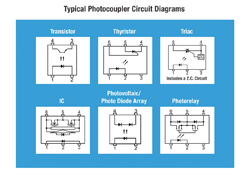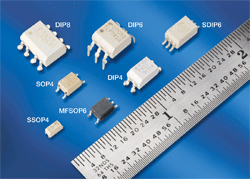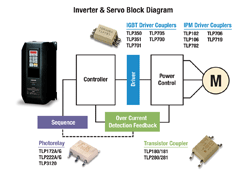Six types of optocouplers address different applications
BY ROGER SHIHToshiba America Electronic ComponentsIrvine, CA
Photocouplers (or optocouplers) are a broad category of device used to isolate two circuits with different ground potential. Typically used for isolation between an input signal and a processor or between a processor and output load, optocouplers are advantageous for eliminating impedance mismatching, improving isolation between input and output, and reducing noise.
A wide variety of optocouplers are available today, including general-purpose devices with transistor, thyristor, or triac output and IC types of optocouplers, photorelays, and photovoltaic couplers. Recent trends address the needs of engineers who must balance conflicting demands for smaller packaging and various requirements for higher-power output, higher-speed switching, and/or lower supply current.
Key parameters to consider
Electrical and structural parameters are a primary consideration to match a specific photocoupler to your application. Major criteria that apply to all categories are noted here. Additional electrical selection criteria for specific categories are discussed in more detail later:
Isolation voltage (BVs).Creepage distance . The minimum distance along the insulator (package) between input pins and output pins.Minimum insulation thickness between two conductors.Isolation clearance. Minimum distance between input pins and output pins.Package type. The isolation parameters are closely related to the package and generally, the smaller the package, the lower the insulation thickness and isolation clearance. Toshiba’s product lineup includes SSOP, MFSOP, SDIP, and DIP packages.Number of channels.Output type. The next major factor to consider is the output required for your application, such as transistor, thyristor, triac, IC, photovoltaic, or MOSFET (photorelay). Six of the most widely used types are described below and shown in Fig. 1 .

Fig. 1. Six variations on photocoupler output types handle most applications.
Output categories and apps
Transistor output. Photocouplers with transistor output are used in signal transmission or in switches in programmable logic controllers, inverters, power supplies, appliances, and modems. Major selection criteria are collector-emitter voltage VCEOthe rated voltage between the collector and emitter; the current transfer ratio IC /IF , low-input type, Darlington transistor output high-current gain, number of channels, and package type.
Triac output. Triac photocouplers can conduct current in both directions and are useful for controlling an ac load. Typical applications include solid-state relays and office automation equipment, as well as appliances, motors, and lighting. Major selection criteria for triac types are the trigger-led current IFT which is the minimum input current necessary to change the device to on-statetypically 5 to 10 mA, the peak on-state voltage VTM, peak off-state voltage (VDRM)often 400 or 600 V and zero-cross or non-zero-crossing. Recent developments in triacs have been focused on package size reduction and new LEDs that enable a lower trigger current.
Thyristor output. Photocouplers with thyristor output are typically used as gate circuits and behave similarly to triac couplers, except in one direction. An example is error amplification and overvoltage protection in a feedback loop, such as in a power supply. Major selection criteria are the same as those for triac couplers.
IC output. IC photocouplers address applications that require more advanced functions on the output-side. Many of the recent advances in optocouplers have been in this category, driven by requirements for high-speed digital transmission. They can generally be divided into three subcategories: high-speed, IGBT/MOSFET driver and IPM driver.
High speed. Photocouplers have an output IC that enables them to transmit data signals in applications such as driving plasma display panels, factory automation equipment, and switching power supplies. Major selection criteria include switching speed and threshold input current IFHL /IFHL , which is the minimum input current necessary to trigger output change.
Notable advances in high-speed devices are package size reduction and reduced supply current. As an example, a recent innovation in the Toshiba photocoupler lineup includes a new 6-pin shrink dual inline package (SDIP) that is 50% smaller than the previous-generation 8-pin DIP. The new package combines the high-isolation characteristics of a DIP package and the compactness of a surface-mount device (see Fig. 2 ).

Fig. 2. The range of photocoupler packages available today shows the trend toward smaller devices.
IGBT/MOSFET driver. The second type of IC photocoupler is a dual-transistor totem-pole output drive, used to drive transistors in inverter and servo motor control in applications such as elevators, appliances and air conditioners. Major selection criteria include, output current IO , supply voltage, CMR (common-mode noise rejection), switching speed, and threshold input current IFHL /IFHL .
Developments in IGBT drivers include miniaturization, higher output current, higher-speed switching, and lower power consumption.
IPM driver. Comparable to IGBT/MOSFET drivers in functionality, the IPM driver targets intelligent power modules and has a lower output current with similar high switching speed. Major selection criteria include data rate and other specifications shared with the previously mentioned high-speed IC couplers. Recent advances in IPM drivers include higher supply voltages and higher-speed switching.
Photorelay. Also known as MOSFET couplers, photorelays perform a switch function. Applications include switches in modems, automated test equipment, set-top boxes, programmable logic controllers and inverters. Major selection criteria include, trigger LED current IFT , minimum input current IF , on-resistance, Capacitance, COFF , off-state voltage VOFF . They come in 1-Form-A (normally open); 1-Form-B (normally closed) versions. Recent developments in photorelays have focused on miniaturization of the photodetector and integration of the MOSFET and photodetector into a single chip. Another trend is low CxR values for test equipment, with values approaching 1 pF.
Photovoltaic/photodiode array (PDA). PDAs can drive power MOSFETs without an external power supply and are commonly used when the switching requirements exceed those of the common photorelay. Major selection criteria include short-circuit current ISC, and open-circuit voltage VOC.

Fig 3. An inverter and servo block diagram shows various types of optocouplers used in one application.
The block diagram of an inverter and servo motor (see Fig. 3) shows three different types of photocouplers in a typical circuit with representative applicable part numbers. The photorelay, shown lower left in the sequence block, is used for switching with isolation. A transistor photocoupler is used for over-current detection in a feedback loop, and IGBT or IPM driver couplers can be used to drive the power module.■
Advertisement
Learn more about Toshiba America Electronic Components





